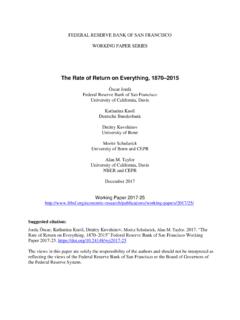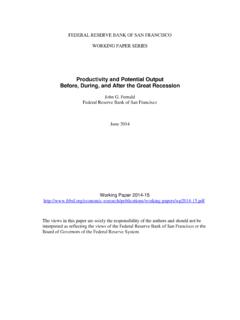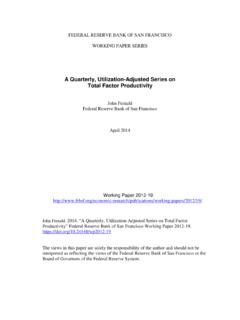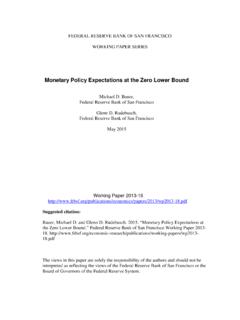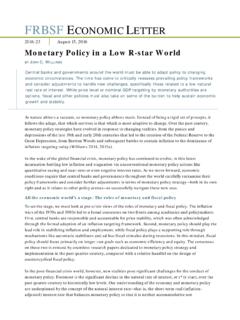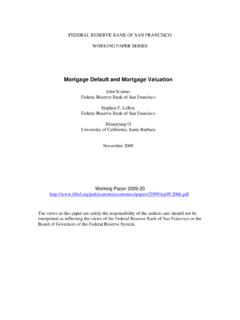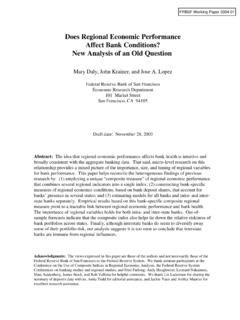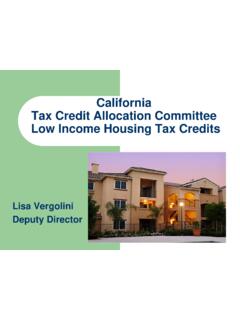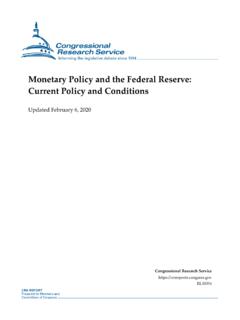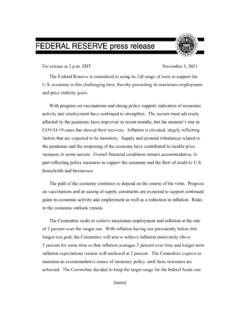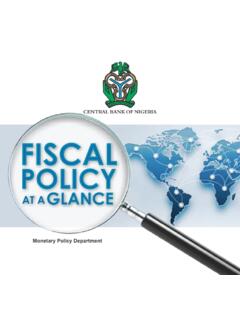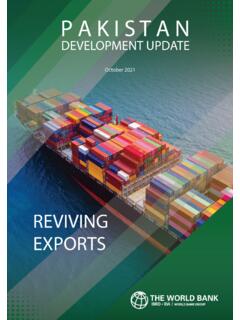Transcription of The Impact of COVID on Potential Output
1 federal reserve BANK OF SAN FRANCISCO WORKING PAPER SERIES The Impact of COVID on Potential Output John Fernald federal reserve Bank of San Francisco Huiyu Li federal reserve Bank of San Francisco March 2021 Working Paper 2021-09 Suggested citation: Fernald, John, Huiyu Li. 2021 The Impact of COVID on Potential Output , federal reserve Bank of San Francisco Working Paper 2021-09. The views in this paper are solely the responsibility of the authors and should not be interpreted as reflecting the views of the federal reserve Bank of San Francisco or the Board of Governors of the federal reserve System. The Impact of COVID on Potential OutputJohn FernaldHuiyu Li Draft: March 22, 2021 AbstractThe level of Potential Output is likely to be subdued post- COVID relative ,capitalinputandfull-employment labor will both be lower than they previously , however, these effects appear relatively modest.
2 In the longrun, labor scarring could lead to lower levels of employment, but the slowpre-recession pace of GDP growth is unlikely to be substantially :Growth accounting, productivity, Potential codes:E01, E23, E24, O47 Fernald: federal reserve Bank of San Francisco and INSEAD; Li: federal reserve Bank ofSan Francisco. We thank Mitchell Ochse for excellent research support. Any opinions andconclusions expressed herein are those of the authors and do not necessarily represent theviews of the federal reserve IntroductionHow will COVID -19 affect the level and growth rate of GDP going forward?The answer to this question matters directly for well-being. But it also mattersfor policy makers. For example, the level and growth of Potential Output hasimportant implications for monetary policymakers assessing the degree ofslack and inflationary paper provides a simple growth-accounting framework to thinkthrough the short-, medium-, and longer-run channels through whichCOVID-19 might affect Potential can quantify some of thechannels.
3 These known knowns suggest a relatively modest Impact so far. Wediscuss a range of other channels that are known unknowns :Theimportance and, in some cases, even the sign of these channels isnecessarily before the coronavirus wreaked its havoc, the normal pace of growthappeared subdued relative to history (See, for example, (Fernald and Li, 2019)).We argue that COVID -19 has not yet caused changes that push this sluggish longer-run growth-rate prediction substantially off will remain low and COVID does not, on its own, seem likely to lead tosharp changes in research effort or in the idea production function that wouldpush us away from the slow-productivity-growth trajectory. Our point forecastis that longer-run (say, 5 to 10 years out) GDP growth is likely to be a littleabove11 course, even if thegrowth rateisn t much affected, there can beimportant changes in thelevelof Potential .
4 After the Great Recession, forexample, Potential Output appeared to be harmed for a time by the substantialreduction in capital accumulation and, potentially, by disruptions to labormarkets. In the near term, our best guess is that COVID -19 will modestlyreduce thelevelof Potential Output through headwinds to labor, capital, and1By definition, we do not discuss unknown unknowns. Historically, unanticipated factorshave probably been the most important determinants of changes in Potential factor productivity (TFP). Labor supply is held back by child caredemands and other sources. Investment has fallen, which hits the economy sproductive capacity; and much of the apparent strength in investment ininformation technology equipment reflects the need to duplicate idle officecapital to allow workers to work from home.
5 The level of TFP is likely to be helddown by adjustment costs associated with the transition to work-for-home, aswell as from the need to adjust supply in part on how long the downturn continues, there is the risk ofhysteresis. It follows that the ultimate effect on the level of Potential Output maydepend on the countercyclical effects of monetary and fiscal policy that seek tolimit the depth of the pandemic-induced this paper, we focus on a production-function definition ofpotential Output : the level of Output given actual capital and technology, ifcapital and labor input (both hours and labor quality) were utilized at normal levels. This is the definition used by the Congressional Budget Office(CBO) and many policy organizations. It is related to, but conceptually a littledifferent than, the flexible-price equilibrium level, because labor supply orfactor utilization might optimally vary in response to some shocks in a way notallowed for with the production-function approach.
6 Nevertheless, Kiley (2013)argues that the Output gap in a carefully specified dynamic stochastic generalequilibrium model, the natural-rate measure of the Output gap comovesreasonably closely with a production-function based measure. (See Fernald(2015) for further discussion.) In any case, in the long run, the two approachesare et al. (2020b) suggest that the level of TFP might persistently be reduced, basedon a large survey of the Great Recession, the persistence of the adverse effects on the level of potentialoutput are controversial. Fernald et al. (2017) argue that temporary effects through capitalaccumulation and labor-market disruptions werenotpersistent. They find that, by 2016, mostof the disappointing Output performance relative to pre-Great-Recession trends reflectednon-recession factors.
7 Cerra et al. (2020) and others, in contrast, interpret the evidence asfavoring hysteresis. Jord a et al. (2020b) discuss additional references on the persistent effects ofdemand shocks on Potential 1: Level and growth rate effects on Potential outputNotes: Figure shows a stylized representation of possible Potential Output paths 1 motivates the organization of the paper. Section 2 discusses thegrowth-accounting framework we use to understand Potential Output at apoint in time, as well as over time. The framework thus describes the positionand slope of the lines in the figure. Section 3 provides background facts on thepre-pandemic trajectory of the economy the blue line in the figure. We thendiscuss possible effects on the level of Potential in Section 4 the red line inthe figure.
8 These level effects may come through capital, labor, or TFP. For anumber of the channels we can quantify the likely effects, which are mostlikely modestly negative. As shown, the level effects are permanent, thoughmany of them are likely to be temporary. In the red line, the longer-run growthrate is unchanged from its pre-pandemic trajectory. But the pandemic mightalso affect the growth rate. So, in Section 5, we then discuss Potential reasonswhy the longer-run growth rate of the economy might change. The dashed lineshows a post- COVID change in the growth rate. In the figure, the growth-ratechange is also associated with a level effect on the jumping off point for the5change in growth. Such a level effect might or might not occur in Potential Output accounting frameworkA standard way to think about Potential Output growth is in terms of growth ininputs as well as in the efficiency with which those inputs are constant-returns aggregate production function, in growth-rateterms, provides the organizing framework for the rest of the paper:dy= dk+ (1 ) (dh+dlq) +dtfp(1)All variables, including factor shares, have time subscripts that we omit Output growth, is capital s Output elasticity (and, understandard conditions, its factor share), anddkis capital-input growth, Effective labor growth is the sum of hours growth,dh, and labor-qualitygrowth,dlq.
9 In the growth-accounting literature, labor quality captures theeffect of education and experience on the labor force (Jorgenson et al., 1987;Bosler et al., 2017).4dtfpis total-factor-productivity growth, which is definedimplicitly by this equation as Output growth not explained by share-weightedinput growth. In that sense, it is a broad measure of technology or measure of technology reflects any changes in factor misallocation as wellas any mismeasurement of factor shares or factor estimating or projecting the variables on the right-hand side of (1), wecan estimate Potential growth. In particular, we can estimate what labor andTFP growth would be if the economy were at full employment, and we canestimate what actual capital input is based on investment flows (and project itusing estimates of future investment).
10 For this reason, (1) provides a useful4 More formally, suppose the production function hasNtypes of labor, so thatY=F(K,H1,H2,..HN). Then the standard Solow accounting that leads to equation (1) wouldimplydy= dk+ (1 ) isLidhi/(1 ) +dtfp, wheresLiis the revenue share of laborinputi. IfH= iHiis total hours worked, thendlq isLidhi/(1 ) framework for thinking about how COVID might affect potentialover the next few will be useful in the long run to write growth in Output identically as thesum of growth in labor productivity and hours:dy= (dy dh) +dh.(2)In standard growth models, steady-state labor-productivity growth,dy dh,depends solely on TFP growth. The reason is that capital growth from equation(1) is endogenous and depends on growth in technology and in labor , rearranging the production function (1), labor productivity is:dy dh= (dk dh dlq) +dlq+dtfp.
